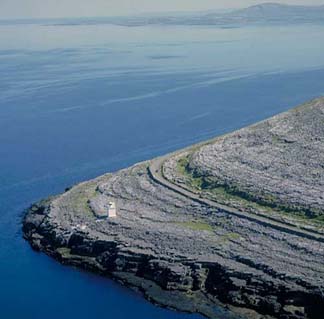
© UnknownBlackhead Lighthouse, where the Burren meets Galway Bay, Co. Clare, Ireland
It wasn't quite
The Day After Tomorrow but it's closer than we thought. An analysis of mud from Lough Monreagh, a lake in Co Clare, has revealed that Europe was struck by a sudden mini ice age 12,800 years ago, suggesting the kind of rapid climate change previously seen only in Hollywood disaster movies.
It was believed that the "Big Freeze" took about a decade to set in. Based on an analysis of Greenland's ice cores, scientists have estimated that the Younger Dryas, as the event is also named, occurred gradually.
However, after analysing mud deposits from Lough Monreagh, William Patterson of the University of Saskatchewan in Canada, has found that
the freeze took only months to take hold.Using a very precise robotic scalpel, Patterson and his colleagues shaved 0.5mm layers from the lake bed, each representing up to three months of sediment. Carbon isotopes in the samples recorded changes to biological activity in the lake, while oxygen isotopes revealed temperature and rainfall patterns.
The tiny mud deposits showed for the first time that temperatures in Ireland dropped suddenly in the space of several months at the time of the Big Freeze.
The measurements, the most exact recorded, showed that, at the start of the Big Freeze, temperatures plummeted and lake productivity came to an abrupt halt.
"It would have been sudden for those alive at the time. It's the equivalent of taking Ireland and moving it to the Arctic over the space of a few months, or a year at most," he said.
Patterson, who has Irish roots, said he chose to analyse lakes in western Ireland after visiting the unusual karst landscape of the Burren, Co Clare, while on holiday.
"I was immediately struck by the Burren. The lakes in the region have the best mud in the world in scientific terms and provide the clearest record yet of the period," he said.
The geologist said that, from his analysis of the mud deposits, it was clear that the lake shut down pretty quickly. "The rate is difficult to judge but it's clear that the temperature dropped suddenly," he said. Younger Dryas was precipitated by a surge of water into the Arctic and North Atlantic oceans after a giant glacial lake covering most of northwest Canada burst its banks.
Patterson, a palaeoclimate researcher, said that this caused the Gulf Stream and the North Atlantic Drift, the primary climate "mood" in the western hemisphere, to slow down.
"It would have been like cutting off the circulation to the western hemisphere," he said. The geologist, who has studied about 200 Irish lakes, presented his findings at a recent climate conference in Finland, and they were reported in the most recent issue of New Scientist magazine.
Patterson said that, while the onset of the mini ice age was abrupt, it ended slowly, with Lough Monreagh taking about two centuries to recover.
Such sudden climate changes are "far from unusual". Recent studies show that a similarly rapid freeze took place about 8,200 years ago.
While Patterson believes that the Earth's recent global warming may not be quite as exceptional as some think, he warned that its effects could be catastrophic based on previous rapid changes in temperature.
Some climatologists have warned that the sudden melting of the Greenland ice sheet could have a similar effect to that of the Big Freeze, although a recent report by the Intergovernmental Panel on Climate Change found that this was unlikely.
was probably not liquid water until the asteroid/comet/whatever hit. Other records such as the half-million "Carolina Bays" stretching up the Atlantic coast of North America, and the similarly-numbered "Playa Lakes" of the great Plains, lend credence to such a scenario. The ice dam didn't break suddenly because there was no ice dam...